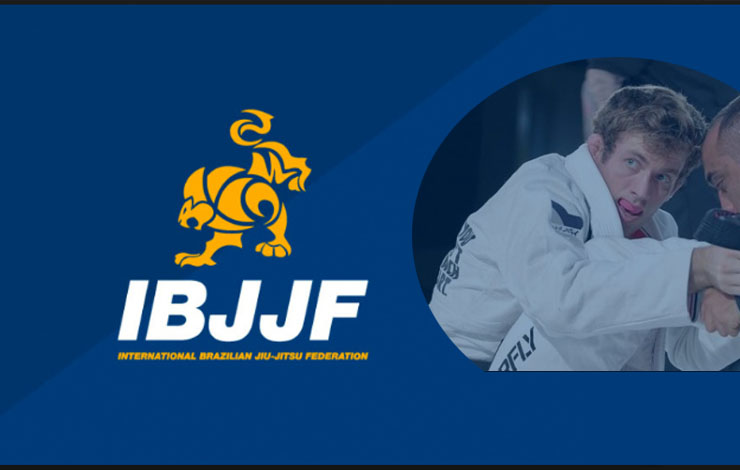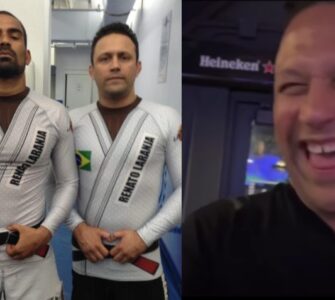Below is the list of updated rules – Guide for 2018
RULES UPDATE GUIDE – 2018
PAGE 7
1.3 Referee Duties
Rule revision:
1.3.7
• While standing, one of the athletes steps into the safety area (unless a takedown attempt has
already been initiated), or when 2/3 of the athletes’ bodies are outside the combat area during
not-yet-stabilized ground fighting,the referee shall interrupt the match and stand both athletes
up in the center of the combat area.
• Points or advantages will be assessed for counting up until the safety area and any
movements performed outside the safety area will not be eligible for counting.
PAGE 14
1.4 Referee Gestures and Verbal Commands
New point:
MATCH CIRCUMSTANCES:
When an athlete grabs the opponent’s sleeves or pant legs with one or more fingers placed
inside the garment.
GESTURE:
One hand placed on top of the opposite arm, holding the wristband.
ORDEM VERBAL:
–
New point:
MATCH CIRCUMSTANCES:
When a change in point, advantage or penalty-count has been communicated to the central
referee by the referee(s) with access to video replay.
GESTURE:
Touch the ear with the fingertips twice, pausing between touches.
ORDEM VERBAL:
–
PAGE 16
ARTICLE 2 – RENDERING DECISIONS
Rule revision:
2.7 – Random Pick
In the event of both athletes suffering accidental injury in a final match where the score is tied at
the moment of the accident and neither athlete is able to continue in the contest, the result shall
be determined by random pick.
PAGE 17
ARTICLE 3 – POINTS SCORING
3.3 – Athletes who arrive at a point-scoring position while caught in a submission hold shall only
be awarded points once they have freed themselves from the attack and stabilized the position
for 3 (three) seconds.
Rule revision:
3.3.1 – Should an athlete achieve point-scoring positions while caught in a submission hold but
only escapes the holdonce no longer in the point-scoring position, will not be awarded points or
advantages for those positions.
New point:
3.3.2 – The 3-second stabilization count for one or several point-scoring positions will be
interrupted, when the opponent lock in a submission hold during the count.
When this happens, the athlete will be awarded an advantage for each of the point-scoring
positions achieved, regardless of whether the opponent is no longer in the positions once the
hold has been escaped from or regulation time has ended.
Rule revision:
3.3.3 – An athlete who reaches one or more positions (cumulative points) but is being attacked
with a submission hold by his/her opponent, shall only be awarded one advantage point if
he/she does not escape the attack prior to the end of the match.
PAGE 18
4.1 Takedown (2 points)
Rule revision:
4.1.1 – When one of the athletes, starting the movement with 2 feet on the ground, causes the
opponent to land with his/her back on the ground, or sideways or seated on the ground, and
maintains the combat on the ground with a stabilized position for 3 (three) seconds.
New point:
4.1.4 – In a sweep movement, when both athletes remain standing for less than 3 seconds and
the athlete on defense throws the opponent so that their back is on the ground or sideways,
shall not be awarded the two points or advantage for the takedown.
New point:
4.1.5 – While in any position starting from guard, where the athletes remain on their feet for 3
seconds, the combat shall then be considered standing combat.
Note: In order to start the 3-second countdown, one of the athletes must have two feet on the
ground and the opponent at least one foot on the ground without the knee of the opposite leg
touching the mat.
New point:
4.1.6 – When the opponent has one or two knees on the ground, the athlete performing the
takedown will only be awarded points if he/she is standing at the moment the takedown is
carried out, unless it is a sweep-defense situation, as described in this article, and meets the
3-second stabilization-count criterion.
Note: No points shall be awarded in situations where the opponent is taken down from their
knees, whether initiated in the guard or any other ground-fighting situation.
PAGE 19
Rule revision:
4.1.8 – An athlete who takes the opponent down in order to defend a standing back-take, where
the opponent has both hooks in place, or one hook in place and neither foot on the ground, will
not be awarded the two points or advantage for the takedown. Even after the position has been
stabilized for three seconds.
PAGE 20
4.2 Guard Pass (3 points)
New point:
• If while attacking from top position, such as an armbar, for example, the athlete ends up on
bottom and does not use his/her legs to prevent the opponent from reaching side-control, no
points or advantages shall be awarded for the guard pass, according to the definition of guard.
4.3 Knee on Belly (2 points)
Rule revision:
• When the athlete on top and free of the opponent’s guard, places the knee or shin(closest to
the opponent’s hip) on the opponent’s belly, chest or ribs, without the opposite knee touching
the ground, maintaining the position stable for 3 seconds, while the opponent is lying on his/her
back or side.
PAGE 24
5.6.1 Advantage from takedown
New point:
• When an athlete applies a takedown or series of takedowns and the opponent returns to their
feet before stabilization is achieved on the ground. The advantage shall only be awarded when
there is no longer a possibility of completing the takedown attempt, in accordance with items 3.4
and 5.5.
5.6.2 Advantage from Guard Pass
New point:
• When the athlete passing guard stacks the opponent, or allows the opponent to roll back
his/herself, controlling the opponent’s back in four-point-kneeling position and maintaining at
least one knee on the ground, without needing to place hooks.
New point:
• When starting from guard (or from pulling guard) the athlete achieves half-guard control over
the opponent, but does not solidify the pass in the ensuing sequence, in accordance with article
5.5.
PAGE 25
5.6.6 Advantage from Sweep.
New point:
• When the athlete unbalances the opponent through a sweep attempt and reaches top position,
but is unable to stabilize the position for 3 seconds.
5.7 Specific cases whereby advantages are no longer awarded.
New point:
5.7.1 – The half-guard position shall not count for an advantage for the athlete on top if it did not
originate from a guard- pass attempt.
Rule revision:
5.7.3 – The athlete who initiates a sweep movement, but deliberately gives up the top position in
order to preserve a defensive position, shall not be awarded an advantage for the sweep.
New point:
5.7.5 – No advantage shall be awarded when an athlete attempting a single-leg takedown traps
the opponent’s leg and drags the opponent to outside the combat area, obliging the referee to
interrupt the combat.
New point:
5.7.6 – No advantage shall be awarded when an athlete attempting to complete a sweep
movement leads the opponent to fall outside the match area without ever landing on top at any
moment during the movement.
PAGE 26
6.1 Disciplinary Penalties:
New point:
6.1.6 – When the athlete exhibits attitudes considered incompatible with the competition
environment, or commits any other misconduct or delict, even if it is carried out prior to or
following the match.
PAGE 27
6.2.2 Serious Fouls
Rule revision:
a) When the athlete kneels or sits (remaining in the position) or pulls guard, without the
establishment of a grip.
j) When an athlete communicates with someone, orally or through gestures, in a manner that
contradicts a decisionmade by the referee.
l) When an athlete exits the mat area after a match but before the referee has announced the
result.
PAGE 28
Rule revision:
t) When an athlete takes more than 20 seconds to re-adjust their(his/her) uniform, they shall be
penalized in a consecutive manner (20 seconds for Gi top and belt, 20 seconds for identification
belt, and 20 seconds for tying the drawstring of the pants, when necessary).
New point:
w) When, in the under-15-year-old-division (for all belts) and in all white belt age groups, an
athlete jumps for closed guard on a standing opponent, including any and all attacks initiated by
jumping guard, such as but not limited to Flying Triangles and Flying Armbars. When such
moves occur, the referee will stand both athletes up again.
Note: Should one athlete be defending an attempted takedown or sweep and jump guard, the
punishment shall include 2 points being awarded to the opponent.
New point:
x) When an athlete during a match or celebrating victory before being announced as the winner
exhibits attitudes not appropriate for the competition environment, but does not qualify as a
disciplinary penalty as described in item 6.1.
Ex: Gestures or exercises meant to suggest physical superiority, dances or attitudes meant to
ridicule within a sporting context.
New point:
6.2.3 Severe Foul
c) When being attacked by a submission hold an athlete commits a penalty that obliges the
referee to interrupt the match.
PAGE 33
ARTICLE 7 – PENALTIES
New point:
Note: In situations whereby both athletes are penalized for lack of combativeness resulting in a
third penalty for each, the match shall be restarted standing.
PAGE 35
ARTICLE 8.1 – Gis and Uniforms
Rule revision:
• Shirts and Rash Guards:
Both genders must wear a shirt of elastic material (skin tight) long enough to cover the torso all
the way to the waistband of the shorts, colored black, white, or black and white, and with at least
10% of the rank color(belt) to which the athlete belongs. Shirts 100% the color of the athlete’s
rank (belt) are also permitted.
Note: For black belts a small red area will be tolerated, but must not decharacterize the athlete’s
rank color.
• Shorts for men:
Board shorts colored black, white, black and white, and/or the color of the rank (belt) to which
the athlete belongs, without pockets or with the pockets stitched completely shut, without
buttons, exposed drawstrings, zippers or any form of plastic or metal that could present a risk to
the opponent, long enough to cover at least halfway down the thigh, and no longer than the
knee.
Also permitted are compression shorts made of elastic material (skin tight) worn beneath the
shorts, in the colors black, white, black and white, and/or the color of the rank (belt) to which the
athlete belongs.
• Shorts, compression shorts and pants for women:
Shorts, compression pants (skin-tight spats) and/or compression shorts colored black, white,
black and white, and/or the color of the rank (belt) to which the athlete belongs. The shorts must
not have pockets or have the pockets stitched completely shut, must not have buttons, zippers
or any kind of plastic or metal that could present a risk to the opponent, and must be long
enough to cover halfway down the thigh and no longer than the knee.
PAGE 37
Rule revision:
8.3.8 – In the female divisions, the athlete will be permitted to cover their heads. The Head
Cover must follow these requirements:
• Must be fixed and made with elastic fabric (or have elastics at the borders).
• Be made without any kind of plastic or hard materials.
• Be made with no strings of any kind.
• Be clear of any inscription or logo.
• Must be totally black, white, black and white, and/or the color of the rank (belt) to which the
athlete belongs.
• Also permitted as part of the female uniform is a single-piece head cover, which should be
made of elastic and cover the neck, ears and completely cover the hair, similar to the head
cover of a wet suit, and be entirely black, white, black and white, and/or the color of the rank
(belt) to which the athlete belongs
PAGE 40
2.4 Disqualification in semifinals and final
Rule revision:
2.4.1 – Semifinals
• Should both athletes accidentally be injured in a tournament semifinal, with the score tied at
the moment of the accident and neither athlete fit to continue in the match, the other semifinal
will be promoted to the status of final. In this case, the injured athletes will be awarded third
place.
PAGE 43
ARTICLE 5 – REGISTRATION
Rule revision:
5.5 – An athlete proven to be a black belt in judo, have experience in freestyle or Greco-Roman
wrestling or to have fought MMA as a professional or amateur, shall not be allowed to enter any
tournament as a white belt.
* In the USA, to have competed at a college level or higher. In other countries, to have
competed in events of national scope.
PAGE 44:
ARTICLE 6 – RULES OF CONDUCT ATHLETE AND ADMINISTRATIVE PUNISHMENTS
Rule revision:
6.1 – When an athlete removes any part of the uniform or kimono when inside the competition
area.
New point:
6.4 – When the athlete or professor displays attitudes considered incompatible with the
competition environment, regardless of whether the match has not yet begun or has already
ended.
*** Relocated itens ***
3.5 When both athletes pull guard at the same time, the athlete who achieves top position first is
awarded an advantage point.
Obs: In cases that the athlete achieves the top position by going straight to the side-mount, he
will not receivepoints nor an advantage for the guard pass.
4.1.9 An athlete who initiates a takedown before the opponent initiates the guard pull shall be
awarded the two points or advantage for the takedown, as described in item 4.1 (Takedown).
4.1.10 An athlete who initiates a takedown after the opponent initiates a guard-pull attempt shall
not be awarded the two points or advantage for the takedown.
4.1.11 When an athlete has a grip on the opponent’s pants and the opponent pulls guard, the
athlete with the grip on the pants shall be awarded two points for the takedown if he/she
stabilizes the top position on the ground for 3 (three) seconds.
Note: If the opponent pulls closed guard and remains suspended in the air, the athlete will have
to put the opponent’s back on the ground within 3 (three) seconds and stabilize the top position
for 3 (three) seconds to be awarded with Takedown points.
4.4.1 – In the case of the mount, when there is a transition straight from back mount to mount or
vice-versa —for being distinct positions— athletes shall be awarded four points for the first
mount and another four points for the subsequent mount, so long as the three-second
stabilization period was achieved in each position.
A true OG of BJJ, Kurt Osiander is a Ralph Gracie black belt who is the head instructor at the Ralph Gracie Academy in San Francisco. The outspoken Kurt Osiander is one of the most well-known instructors in the world and certainly has a tough old school BJJ game. Kurt recently released his first instructional series for BJJ Fanatics entitled Fundamentals of a Jiu Jitsu Renegade where he teaches his no BS and hard nosed approach to BJJ. Now grab yourself a copy of Fundamentals of a Jiu Jitsu Renegade and be sure to add code ‘BJJEE’ to get 10% off!


















